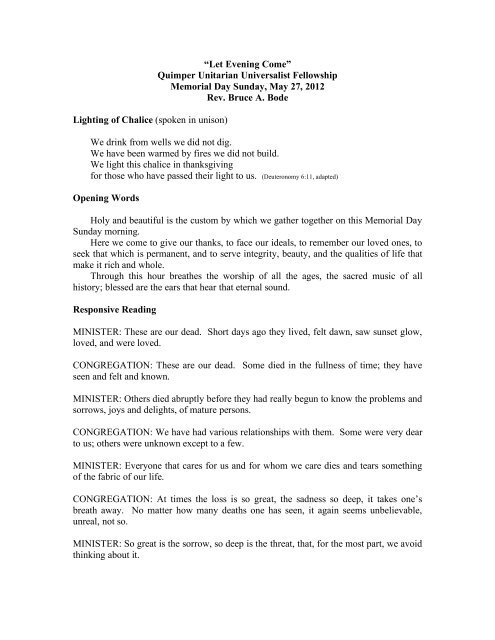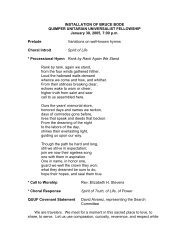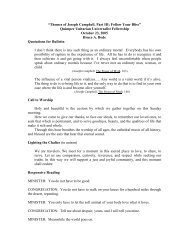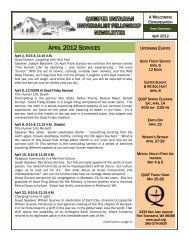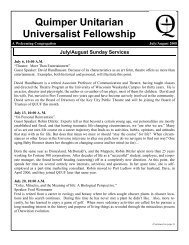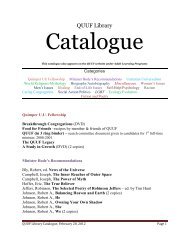Let Evening Come - Quimper Unitarian Universalist Fellowship
Let Evening Come - Quimper Unitarian Universalist Fellowship
Let Evening Come - Quimper Unitarian Universalist Fellowship
Create successful ePaper yourself
Turn your PDF publications into a flip-book with our unique Google optimized e-Paper software.
Lighting of Chalice (spoken in unison)<br />
“<strong>Let</strong> <strong>Evening</strong> <strong>Come</strong>”<br />
<strong>Quimper</strong> <strong>Unitarian</strong> <strong>Universalist</strong> <strong>Fellowship</strong><br />
Memorial Day Sunday, May 27, 2012<br />
Rev. Bruce A. Bode<br />
We drink from wells we did not dig.<br />
We have been warmed by fires we did not build.<br />
We light this chalice in thanksgiving<br />
for those who have passed their light to us. (Deuteronomy 6:11, adapted)<br />
Opening Words<br />
Holy and beautiful is the custom by which we gather together on this Memorial Day<br />
Sunday morning.<br />
Here we come to give our thanks, to face our ideals, to remember our loved ones, to<br />
seek that which is permanent, and to serve integrity, beauty, and the qualities of life that<br />
make it rich and whole.<br />
Through this hour breathes the worship of all the ages, the sacred music of all<br />
history; blessed are the ears that hear that eternal sound.<br />
Responsive Reading<br />
MINISTER: These are our dead. Short days ago they lived, felt dawn, saw sunset glow,<br />
loved, and were loved.<br />
CONGREGATION: These are our dead. Some died in the fullness of time; they have<br />
seen and felt and known.<br />
MINISTER: Others died abruptly before they had really begun to know the problems and<br />
sorrows, joys and delights, of mature persons.<br />
CONGREGATION: We have had various relationships with them. Some were very dear<br />
to us; others were unknown except to a few.<br />
MINISTER: Everyone that cares for us and for whom we care dies and tears something<br />
of the fabric of our life.<br />
CONGREGATION: At times the loss is so great, the sadness so deep, it takes one’s<br />
breath away. No matter how many deaths one has seen, it again seems unbelievable,<br />
unreal, not so.<br />
MINISTER: So great is the sorrow, so deep is the threat, that, for the most part, we avoid<br />
thinking about it.
CONGREGATION: We hurry away from the grave; we take up again, with alacrity, the<br />
daily problems and confusions which seem so much easier to handle than the imminent<br />
specter of death.<br />
MINISTER: But the richness of our life depends upon how we surround ourselves with<br />
those who care for us, and how much we live in the spirit that does not pass away with<br />
the passing of the body.<br />
CONGREGATION: We need to treasure more deeply those who have loved us and died;<br />
they give greater joy and beauty, greater meaning and worth to our days, because they<br />
help us to see, to feel, to hear, and to understand more deeply.<br />
MINISTER: Will not these qualities we have met in our departed loved ones go on to<br />
infuse all the days of our lives? Do we not owe gratitude and remembrance wherever we<br />
have met with any joy and intimacy?<br />
CONGREGATION: And so this day we honor these, our dead, and all those whom we<br />
have known in the past no longer with us. (Dr. Duncan E. Littlefair)<br />
Call to Remembrance<br />
Please stand now, as you are able, and honor with your silence those individuals<br />
connected with this congregation who have died, not only in this past year, but all those<br />
who have been part of this <strong>Fellowship</strong> from its beginning.<br />
Harry Jordan<br />
Richard Earhart<br />
Lucy Redkey<br />
Mary W. Erickson<br />
Bernice Ruth Johanson<br />
Daniel Plachta<br />
Jonathan Conant<br />
Earl Willetts<br />
Eula Dennison<br />
Mary Jordan<br />
Louise Nomura<br />
William John Wynn<br />
Arthur David Smith<br />
Ruth Humphrey<br />
Lois Anne Overton<br />
Judy Allen<br />
George Harper<br />
Dick Shipley<br />
Josh Stewart<br />
Craig Stout<br />
John Butler<br />
Henry Redkey<br />
Micky Douhan<br />
Leo Lake<br />
Niels Holm<br />
Ruth Butler<br />
Diana Johanson<br />
Eleanor Finlay Otte<br />
Andrew Palmer<br />
Margaret McLaughlin<br />
Jeanette Earhart Lewis<br />
James Humphrey
Everett Whealdon<br />
Kathleen Bruskin<br />
Vance Lewton<br />
Marjorie Willets<br />
James Edward Everett<br />
Ruth Russell<br />
Desiree W. Whipple<br />
Irene Osborne<br />
Lucille Watson<br />
Anya Kurotchkin Lincoln<br />
Gwyneth Pederson<br />
Trevor Wilson<br />
Robert (Bob) Knudson<br />
Joel Johanson<br />
Norma Davidson<br />
Clara Klug<br />
Karen Driscoll<br />
Jan Givens<br />
Erica Brunquist<br />
Sandy Stewart<br />
Carl Nelson<br />
Helen Wynn<br />
Carol Albrecht<br />
Tammy Garnett<br />
We honor those who have lived and died in our religious community. We gain strength<br />
and confidence from their deeds and memories. Their spirit remains alive among us.<br />
Reading<br />
Memorial Day had its origin at the end of the Civil War when on this last weekend in<br />
May of 1868, General John A. Logan, commander-in-chief of the Grand Army of the<br />
Republic, honored the soldiers and sailors who had given their lives in that horrific civil<br />
conflict. And he honored the war dead, not only of the victors but of both Union and<br />
Confederate soldiers who were buried at the Arlington National Cemetery. He did so by<br />
decorating their graves with flowers. Thus, this day was first known as Decoration Day,<br />
a name that still echoes in memory from my youth.<br />
Later Decoration Day become Memorial Day, a day set aside by our country to<br />
memorialize and pay tribute to all those who have given their lives in military service for<br />
our country. And now, of course, the Memorial Day remembrance has expanded beyond<br />
that, becoming a general remembrance of our loved ones who have died.<br />
Here, in our religious community, as in our “Call to Remembrance,” we use this<br />
Memorial Day Sunday for remembering loved ones from this <strong>Fellowship</strong> who have died.<br />
And this morning we will consider the theme of death and how to approach it.<br />
My reading, which will stand in sharp contrast to the anthem that the choir will sing<br />
titled, “<strong>Let</strong> <strong>Evening</strong> <strong>Come</strong>,” the words of which will serve as the text for my sermon, will<br />
have to do with not acquiescing to death, but fighting it all the way.<br />
It’s a powerful poem by the celebrated and wild Welsh poet Dylan Thomas, who lived<br />
from 1914-1953, dying at the young age of 39. The poem, Thomas’ most well-known<br />
poem, is titled, “Do Not Go Gentle Into That Good Night.” It was written when his aged,<br />
blind father was dying.
Do Not Go Gentle Into That Good Night<br />
Do not go gentle into that good night,<br />
Old age should burn and rave at close of day;<br />
Rage, rage against the dying of the light.<br />
Though wise men at their end know dark is right,<br />
Because their words had forked no lightning they<br />
Do not go gentle into that good night.<br />
Good men, the last wave by, crying how bright<br />
Their frail deeds might have danced in a green bay,<br />
Rage, rage against the dying of the light.<br />
Wild men who caught and sang the sun in flight,<br />
And learn, too late, they grieved it on its way,<br />
Do not go gentle into that good night.<br />
Grave men, near death, who see with blinding sight<br />
Blind eyes could blaze like meteors and be gay,<br />
Rage, rage against the dying of the light.<br />
And you, my father, there on the sad height,<br />
Curse, bless, me now with your fierce tears, I pray.<br />
Do not go gentle into that good night.<br />
Rage, rage against the dying of the light.<br />
Introduction<br />
“LET EVENING COME”<br />
As I indicated in the introduction to my reading, the theme for the Memorial Day Holiday<br />
is remembrance – remembrance of those who have given their lives in military service to<br />
their country.<br />
From that we get to a more general remembrance of departed loved ones no longer with<br />
us.<br />
And from that we get to the theme of death and the question of how to approach death.<br />
And from that we get to the poem that the choir sang this morning, which is often read at<br />
memorial services to bring comfort to those who are grieving the loss of loved ones.
And that is how I have often used this poem. It’s been one of the consistent poems that<br />
I’ve used over the years at memorials services at which I have officiated.<br />
What is the subject of the poem?<br />
However, as I have looked more closely at this poem, and as I have become more<br />
acquainted with the poetry of Jane Kenyon – I facilitated an adult Learning Programs<br />
class on her poetry this past winter – I have come to realize that this poem is, first of all,<br />
simply about the coming of nighttime, the daily slide from light to dark. It’s not using<br />
night as a metaphor for death, as I had assumed.<br />
For example, the author’s husband, fellow poet Donald Hall, in a book titled, Life after<br />
Jane, an elegy written following the death of his wife from leukemia in 1995 at the alltoo-young<br />
age of 48, wrote:<br />
Jane speaks of ‘evening,’ and those who translate ‘evening’ immediately into ‘death’<br />
are missing the poem’s notion. (quoted in Jane Kenyon: A Literary Life, John H. Timmerman, p. 175)<br />
The poem<br />
So, let’s look together at this poem.<br />
<strong>Let</strong> the light of late afternoon<br />
shine through chinks in the barn, moving<br />
up the bales as the sun moves down.<br />
<strong>Let</strong> the cricket take up chafing<br />
As a woman takes up her needles<br />
And her yarn. <strong>Let</strong> evening come.<br />
<strong>Let</strong> dew collect on the hoe abandoned<br />
in long grass. <strong>Let</strong> the stars appear<br />
and the moon disclose her silver horn.<br />
<strong>Let</strong> the fox go back to its sandy den.<br />
<strong>Let</strong> the wind die down. <strong>Let</strong> the shed<br />
go black inside. <strong>Let</strong> evening come.<br />
To the bottle in the ditch, to the scoop<br />
in the oats, to air in the lung<br />
let evening come.<br />
<strong>Let</strong> it come, as it will, and don’t<br />
be afraid. God does not leave us<br />
comfortless, so let evening come.
Taking the poem at face-value<br />
Taking this poem, then, at face-value, in its literal, straight-forward meaning, it’s simply<br />
a poem about the coming of the night, and about surrendering to the coming of the night.<br />
This poem uses the word “let” twelve times. It, thus, can be taken as a kind of<br />
supplicatory prayer in the face of fear of the dark and the unknown. “You don’t have to<br />
be afraid of the dark,” says the poem, “for you are accompanied into the night by a power<br />
larger than your fear, which will be with you.” Thus:<br />
“Be not afraid.”<br />
“May I not afraid.”<br />
“<strong>Let</strong> me not be afraid.”<br />
“I need not be afraid.”<br />
The feeling tone of this poem is one of surrender, acceptance, and embrace. Biographer<br />
John Timmerman writes:<br />
The poem reads as an affirmation of the natural rhythms of life – physically,<br />
biologically, and psychologically. If anything, it is a poem of great peace, regardless<br />
of whether the light rises or falls. (Jane Kenyon: A Literary Life, John H. Timmerman, p. 175)<br />
A rural setting<br />
The images and objects referred to in this poem are from the poet’s surroundings. Jane<br />
Kenyon, whose dates are 1947-1995, lived for most of her adult life with her husband,<br />
Donald Hall, at his ancestral home, called Eagle Pond Farm, in Wilmot, New Hampshire.<br />
Thus, the barn with its bales of hay, the chafing cricket, the hoe abandoned in the long<br />
grass, the fox returning to its sandy den, the shed growing dark inside, the bottle in the<br />
ditch, and the scoop in the oats – all of these things are related to their farm.<br />
As the light departs and the night comes on, there is a comfort in simply naming these<br />
objects … like a child at bedtime saying goodnight to all the important pieces of his or<br />
her surroundings.<br />
Goodnight Moon<br />
This poem brings to my mind the children’s book, Goodnight Moon, that my wife and I,<br />
along with countless other parents, have read to their young children to send them<br />
peacefully into night-time sleep.<br />
This little classic, written by Margaret Wise Brown and illustrated by Clement Hurd, was<br />
first published in 1947, the year of Jane Kenyon’s birth – and mine as well. It describes a<br />
bunny’s bedtime ritual of saying goodnight to the various objects and persons that are<br />
either in the bunny’s room or pictured in the bunny’s room.
(When I was on the ferry last evening coming from Family Camp with Kathy Stevenson,<br />
I mentioned to her that I was planning to say something about Goodnight Moon. She<br />
then proceeded, from memory, to relate the text of that book to me. I said, “How did you<br />
know that?” “Thirty-three years of Rainbow School.”)<br />
I don’t have the text memorized, but here is what the bunny – and thus the child – bids<br />
goodnight to:<br />
Goodnight room<br />
Goodnight moon<br />
Good night cow jumping over the moon<br />
Goodnight light<br />
And the red balloon<br />
Goodnight bears<br />
Goodnight chairs<br />
Goodnight kittens<br />
And goodnight mittens<br />
Goodnight clocks<br />
And goodnight socks<br />
Goodnight little house<br />
And goodnight mouse<br />
Goodnight comb<br />
And goodnight brush<br />
Goodnight nobody<br />
Goodnight mush<br />
And goodnight to the old lady<br />
whispering “hush”<br />
Goodnight stars<br />
Goodnight air<br />
Goodnight noises everywhere<br />
So, perhaps, “<strong>Let</strong> <strong>Evening</strong> <strong>Come</strong>,” can be taken as a kind of adult-version of Goodnight<br />
Moon.<br />
There’s something comforting in the prayer-like mantra of simply naming the objects<br />
around you. When you’re having trouble going to sleep, just start counting or naming<br />
things – objects, persons, sheep, whatever. I often go to sleep by re-playing in my mind<br />
the last round of golf that I’ve played. By the time I’m to the fifth hole, I’m sound<br />
asleep.<br />
The poet’s own struggle<br />
The surrender to the night and the natural rhythms of life was something with which the<br />
poet herself struggled – something that she had to work through. In earlier poems, as<br />
John Timmerman points out, the “shadowland between light and darkness is often strung
with anxiety and fear.” (p. 177) And, again, he says: “… the intermingling of light and<br />
shadow, that indeterminate time of day … always seemed to intrigue and puzzle her.” (p.<br />
173)<br />
Regarding the origin of the poem, in a letter to her good friend and fellow poet, Alice<br />
Mattison, dated April 16, 1986, four years before its publication, Jane Kenyon wrote:<br />
I have written something new, which I am very excited about. While I was in<br />
A[nn] A[rbor] [which is where the poet grew up] I heard my mother say, “<strong>Let</strong><br />
<strong>Evening</strong> <strong>Come</strong>.” We were talking about getting depressed as the day goes on, and<br />
wanting bedtime to come so you can become oblivious…<br />
(Mattison, “<strong>Let</strong> It Grow in the Dark Like a Mushroom,-pp. 131-32; quote in Timmerman, p. 175)]<br />
Indeed, throughout her life, Jane Kenyon suffered from depression, diagnosed when she<br />
was thirty-eight as bi-polar manic depression, though rarely on the manic side. In one of<br />
her greatest poems titled, “Having It Out with Melancholy,” she wrote:<br />
Often I go to bed as soon after dinner<br />
As seems adult<br />
(I mean I try to wait for dark)<br />
in order to push away<br />
from the massive pain in sleep’s<br />
frail wicker coracle.<br />
A “coracle” is a small round boat made from animal skins stretched over a wicker frame.<br />
Like being on a calm lake in a small boat that has been pushed from shore, the sleep of<br />
nighttime provides a temporary respite from the massive pain of the day.<br />
But, of course, the relief will be temporary, for that little boat, that “frail wicker coracle,”<br />
will again come to shore, and often before daybreak.<br />
In these circumstances of depressive emotional pain, the supplication to “let evening<br />
come” would be quite different than the feeling tone we actually find in this poem. That<br />
is, not so much a tone of acceptance, surrender, and embrace; but, rather, a plea for relief,<br />
a cry to escape, a pulling of the blankets over the head, a curling up, perhaps, in a fetal<br />
position.<br />
So, it appears that the poet has worked through an issue for herself and found some real<br />
peace.<br />
Two poems of Robert Frost<br />
But before speaking more about that peace and acceptance, let me contrast the theme of<br />
the embrace of the night and of nature’s rhythms that we find in “<strong>Let</strong> <strong>Evening</strong> <strong>Come</strong>”<br />
with two of Robert Frost’s poems – Robert Frost, who also suffered severe bouts of<br />
depression, but who also claimed to be able “to mock anything out of his system” – a<br />
claim I somewhat doubt.
The first poem by Frost is titled, “<strong>Come</strong> In.”<br />
<strong>Come</strong> In<br />
As I came to the edge of the woods,<br />
Thrush music – hark!<br />
Now if it was dusk outside,<br />
Inside it was dark.<br />
Too dark in the woods for a bird<br />
By sleight of wing<br />
To better its perch for the night,<br />
Though it still could sing.<br />
The last of the light of the sun<br />
That had died in the west<br />
Still lived for one song more<br />
In a thrush’s breast.<br />
Far in the pillared dark<br />
Thrush music went –<br />
Almost like a call to come in<br />
To the dark and lament.<br />
But no, I was out for stars:<br />
I would not come in.<br />
I meant not even if asked,<br />
And I hadn’t been. (Robert Frost (1874-1963)<br />
Here, as with “<strong>Let</strong> <strong>Evening</strong> <strong>Come</strong>,” the coming of the night brings up the concern of loss<br />
and fear. The poet at the edge of the dark woods hears the final song of the thrush before<br />
it rests for the night, and to him it sounds like a song of lament – and almost like a call for<br />
him to join the thrush in a time of lament.<br />
But the poet resists this thought. He is out to view the stars; he is not out for lament. He<br />
decides he will not join the thrush in his song of lament. He will not “come in” to the<br />
dark … even if invited. And the poet decides abruptly that he has not been invited. End<br />
of the matter!<br />
Thus, whereas Kenyon’s poem pronounces a theme of surrender in relation to the coming<br />
of the night – and by extension a giving over to grief and sorrow – Frost resists and<br />
pushes back.<br />
A second poem of Frost, which also has to do with the coming of the night and the dark,<br />
is titled, “Acceptance.”
Acceptance<br />
When the spent sun throws up its rays on cloud<br />
And goes down burning into the gulf below,<br />
No voice in nature is heard to cry aloud<br />
At what has happened. Birds, at least, must know<br />
It is the change to darkness in the sky.<br />
Murmuring something quiet in her breast,<br />
One bird begins to close a faded eye;<br />
Or overtaken too far from his nest,<br />
Hurrying low above the grove, some waif<br />
Swoops just in time to his remembered tree.<br />
At most he thinks or twitters softly, “Safe!<br />
Now let the night be dark for all of me.<br />
<strong>Let</strong> the night be too dark for me to see<br />
Into the future. <strong>Let</strong> what will be, be.” (Robert Frost (1874-1963)<br />
In the first Frost poem I read, the poet thought the bird, the thrush, might be inviting him<br />
to lament. In this poem, a bird who can’t make it back to his nest – or maybe he does – at<br />
least finds a familiar place of shelter and says, “Safe.”<br />
The poem is titled “Acceptance,” and in it there is the acceptance of nature: with the<br />
setting of the sun, “No voice in nature is heard to cry aloud/ At what has happened.” But<br />
this would seem to be a blind acceptance, not a conscious one.<br />
But birds at least have a little consciousness of the coming of the night. They take note<br />
of the change from light to darkness.<br />
But do these birds accept the rhythms of nature, or just close their eyes to them?<br />
The bird that Frost quotes uses the dark to shield him against knowledge of the future –<br />
“<strong>Let</strong> the night be too dark for me to see/ Into the future.” In other words, “Don’t let me<br />
see what will be.” But, on the other hand, “<strong>Let</strong> what will be, be.”<br />
Is this acceptance? As is often the case, Frost likes to have it both ways, and keep the<br />
reader guessing.<br />
A greater acceptance<br />
Jane Kenyon’s poem, “<strong>Let</strong> <strong>Evening</strong> <strong>Come</strong>,” clearly has a greater sense of embrace and<br />
acceptance … which is why it is so often read at memorial services in relation to the<br />
acceptance of death.<br />
Earlier I quoted her husband Donald Hall when he said, “Jane speaks of ‘evening,’ and<br />
those who translate ‘evening’ immediately into ‘death’ are missing the poem’s notion.”
However, there is a second part to Donald Hall’s statement that I didn’t read, which goes<br />
like this:<br />
Yet the mind leaps to find analogy – humans are symbol-seekers – and people read<br />
this poem at funerals. Someone has carved it into a gravestone. (quoted in Jane Kenyon: A<br />
Literary Life, John H. Timmerman, p. 175)<br />
As I said earlier, I have often used Kenyon’s poem at memorial services. It is the poem<br />
by which I originally knew her name.<br />
And, in particular, the last line of the poem that reads, “God does not leave us/<br />
comfortless, so let evening come” … that line, to me, moves the poem toward to the<br />
theme of death and the facing of the coming of the night as being a metaphor for facing<br />
death.<br />
“Do Not Go Gentle into That Good Night”<br />
The poem that I read earlier in my reading from Dylan Thomas, “Do Not Go Gentle into<br />
That Good Night,” also often gets quoted at memorial services. And in that poem “night”<br />
is very clearly a metaphor for “death.”<br />
But the approach of that poem, as I said, is in sharp contrast to Kenyon’s poem. It is the<br />
poet’s strong protest against death. Despite death being referred to as “that good night,”<br />
the poet resists its coming and seems to believe that one should fight to the end – “Rage,<br />
rage against the dying of the light.”<br />
(I’ve had the experience on a couple of occasions early on in my ministry of persons<br />
requesting that this poem to be read at memorial services because they have heard of it<br />
and know it’s a powerful poem, then somewhat repenting of their choice afterwards, for<br />
they had not heard it as such a poem of resistance to death. And, so, now, if someone<br />
that requests that poem, I ask them to take a good look at it to be certain this is the tone<br />
they want.)<br />
Giving the ego its rights<br />
On the other hand, Dylan Thomas’ poem does express an important element that I try to<br />
get at in memorial services. I call it, “letting the ego have its rights.” That is, allowing<br />
our ego, our sense of personal identity, to have its say, and to cry out against the losses it<br />
experiences, including its own coming dissolution.<br />
There’s a film interview of Jane Kenyon and her husband Donald Hall by Bill Moyers<br />
that was done in 1993, two years before her death – and before she knew she had<br />
leukemia. But there had been other brushes with death, particularly illnesses of her<br />
husband involving complicated operations for cancer. And Kenyon speaks candidly in<br />
those interviews of there being a lot of “howling” going on in their house at those times.
“Howling?” Moyers asks.<br />
“Yup, howling,” replies Jane Kenyon, “not a very Yankee trait.”<br />
This is what I call “letting the ego have its rights” – allowing it – encouraging it, actually<br />
– to express itself. This is the first thing I try to get at in memorial services at which I<br />
officiate – not to try to be strong in the face of death, or to think only happy thoughts<br />
related to our loved ones; but, first of all, to allow ourselves to feel the pain of loss, the<br />
distress of regret, and to let ourselves be drenched by sorrow, like standing under a<br />
pouring waterfall.<br />
Perhaps, it’s because Kenyon does not deny the ego its rights that she is able to write the<br />
poem, “<strong>Let</strong> <strong>Evening</strong> <strong>Come</strong>.” When the grief and anger and sorrow and regret of the ego<br />
is recognized and honored, then the ego is also in a position to surrender to that which is<br />
larger than itself – to let go and to give itself over to the larger rhythms of nature. In<br />
Kenyon’s words, this is a surrender to the God who “does not leave us comfortless.”<br />
In another interview that Bill Moyers had with Jane Kenyon, the interview ends as<br />
follows. Moyers asks:<br />
“How did you come to write ‘<strong>Let</strong> <strong>Evening</strong> <strong>Come</strong>’? So many people say that’s<br />
their favorite of your poems.”<br />
Jane Kenyon responded, “That poem was given to me.”<br />
Moyers: “By?”<br />
Kenyon: “The muse, the Holy Ghost. I had written all the other poems in the<br />
book in which it appears, and I knew that it was a very sober book. I felt it needed<br />
something redeeming. I went upstairs one day with the purpose of writing<br />
something redeeming, which is not the way to write, but this [poem] just fell out. I<br />
really didn’t have to struggle with it.”<br />
Moyers: “Do you still believe what that poem expresses, given Don’s cancer<br />
[her husband, Donald Hall] and your own illness [Kenyon’s chronic depression].”<br />
Kenyon: “Yes. There are things in life that we must endure which are all but<br />
unendurable, and yet I feel that there is a great goodness. Why, when there could<br />
have been nothing, is there something? This is a great mystery. How, when there<br />
could have been nothing, does it happen that there is love, kindness, beauty?”<br />
(From The Language of Life, p. 237)<br />
Conclusion<br />
It’s possible for us humans to imagine the complete absence of everything, to experience<br />
the shock of possible non-being.
But there’s not nothing, there’s something, always something!<br />
And, to me, that power of being … which forever overcomes non-being … which rolls<br />
through all things … infinite, eternal, forward-pushing … the source of all individual<br />
beings … and the abysmal ocean into which all individual beings dissolve … that power<br />
of being abides … it creates and keeps on creating … and that is the creativity in which<br />
we ultimately rest. Thus,<br />
<strong>Let</strong> evening come…<br />
<strong>Let</strong> it come, as it will, and don’t<br />
be afraid.<br />
Hymn: “Abide with Me”<br />
Spoken Benediction<br />
Our closing words are from Jane Kenyon’s poem, “Spring <strong>Evening</strong>”:<br />
Again the thrush affirms<br />
both dusk and dawn. The frog<br />
releases spawn in the warm<br />
inlet of the pond. Ferns<br />
rise with the crescent moon,<br />
and the old farmer<br />
waits to sow his corn. (Jane Kenyon: Collected Poems, p. 285)<br />
Extinguishing of the Chalice<br />
We extinguish this flame,<br />
but not the light of truth,<br />
the warmth of community,<br />
or the fire of commitment.<br />
These we carry in our hearts<br />
until we are together again.<br />
(NOTE: This is a manuscript version of the service given by The Reverend Bruce A.<br />
Bode at the <strong>Quimper</strong> <strong>Unitarian</strong> <strong>Universalist</strong> <strong>Fellowship</strong> on Memorial Day Sunday, May<br />
27, 2012. The spoken message, available on CD at the <strong>Fellowship</strong>, may differ slightly in<br />
phrasing and detail from this manuscript version.)


